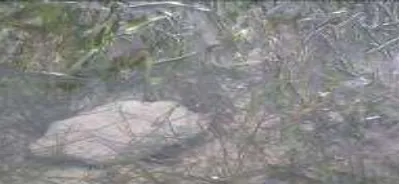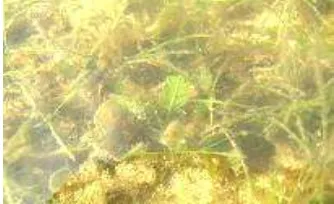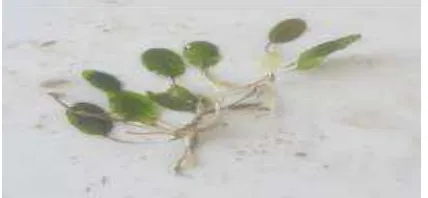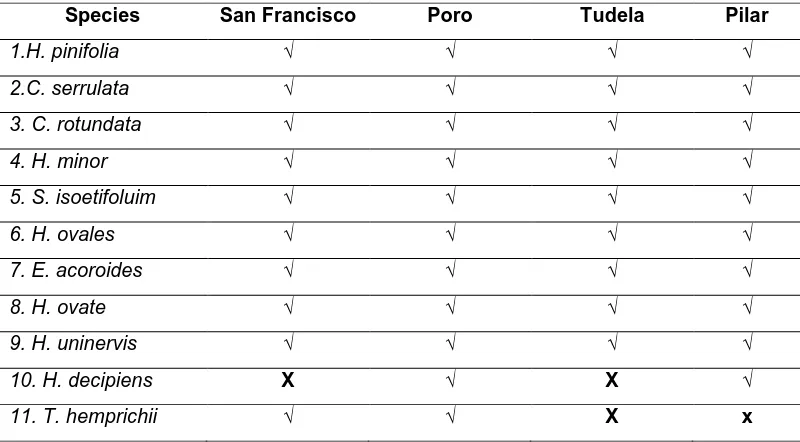SPECIES DIVERSITY OF SEAGRASSES IN CAMOTES ISLANDS,
CENTRAL PHILIPPINES
Serapion N. Tanduyan, Berenice T. Andriano and Ricardo B. Gonzaga
Cebu Technological University, San Francisco, Cebu, Philippines Email: [email protected]/ fax no. 0324970318
ABSTRACT
Seagrasses of Camotes Islands were studied to determine its species diversity. A transect-quadrat method was used where 3 transects were laid in each station taking into account its species in the four municipalities of Camotes Islands which are San Francisco, Poro, Tudela and Pilar. Results show that there were 11 species of seagrasses found in the four municipalities of Camotes Islands which are Halophila decipiens, Thalassia hemprichii, Cymodocea rotundata, Cymodocea serrulata, Halodule pinifolia, Halodule uninervis, Halophila minor, Halophila ovalis, Halophila ovata, Enhalus acoroides and Syringodium isoetifolium Halophila decipiens and Thalassia hemprichii are the distinct species of seagrass found in the municipalities of Poro and San Francisco, respectively while there are 9 species that are common in all the municipalities that include: Cymodocea rotundata, Cymodocea serrulata, Halodule pinifolia, Halodule uninervis, Halophila minor, Halophila ovalis, Halophila ovata, Enhalus acoroides and Syringodium isoetifolium.
Keywords: Seagrass, Species Diversity, Camotes Islands, Transect-quadrat method
INTRODUCTION
Seagrass is one diverse ecosystem where it supports diverse flora and fauna in marine waters. It is the only group of flowering plants or angiosperms that inhabit the coastal and marine environment of the temperate and tropical region. (Phang, 2000). Of the three marine ecosystems in coastal areas, it occupied the mid part of it.
It serves as the feeding, breeding and nursery grounds of marine organisms of commercial importance. They are highly productive and contribute greatly in supplying oxygen in the seas as well as sequestrations of carbon. Their presence has been abused by humans due to lack of knowledge and information regarding this ecosystem. Siltation and over harvesting of associated flora and fauna in seagrass beds resulted to its destruction. The gleaners mercilessly pull out the plant in searching for bivalves destructing not only the plant but also its habitat.
that is why its status and condition should be assessed in order to draw out plans for flowering plants living entirely submerged and sharing numerous convergent morphological and physiological characteristics.
Seagrasses are very important component of the coastal ecosystem because of their part in trophic and nursery importance for fishes and larger vertebrates. They are directly consumed in the form of leaves and indirectly consumed in the form of detritus and epiphytes by animal species including crabs, prawns, shells and fishes (Edgar et. al 2001).
Decomposition of seagrass is one feature in the seagrass beds. They are usually caused by the physical and chemical breakdown of dead organisms evolving other organisms notably bacteria, fungi and animals. In most marine-angiosperm-based ecosystems, only a small amount of the leaf production is consumed in the plant in situ by echinoderms, crustaceans, and fishes and in the tropics, turtles and dugongs most consumption of the leaves occurs through the action of crustaceans, gastropods and microorganism in the letter (Walker et al.2010)
Den Hartog (1997) mentioned the functions of seagrass beds. One is that it become exposed during low tide. Some insects (larvae) and Talitridae (Amphipoda) ate seagrasses when they are washed ashore and begin to decompose. They serve as nurseries and shelter to many organisms.
vegetation softens the water movement by currents and waves and offers calm underwater space within it. Depending on hydrodynamic conditions, suspended silt and other colloidal substances form sediments in the seagrasses bed.
By photosynthetic activity seagrasses produce and consume CO2 dissolved in the water during daytime. High O2 concentration in seagrass bed can support high densities of various animal forms. Excessive illumination in the daytime is diminished by the leaf canopy, protecting the bottom from isolation and permitting a shaded microenvironment to develop at the base of the vegetation.
Seagrass beds serve as feeding, breeding and nursery grounds for a host of marine organisms, especially fishery species of commercial importance (Phang 2000). In Southeast Asia seagrass is used in many ways: as packing material, paper, children’s toys, and compost for fertilizer, folder and materials for baskets and mats (Fortes 1995).
Seagrasses are highly productive and contribute greatly to oxygenation of the seas as well as carbon sequestration, leading to reduction in the effects of global warming (Phang 2000).
Many important fishery species start their lives in seagrass beds and migrate to other marine ecosystems. Seagrass beds together with coral reef supply more than one-fifth of the fish catch in East Asia (McManus 1988). The amount of fish found in seagrass beds is five times that in muddy and sandy habitats.
Because of their shallow sublittoral and some extent intertidal existence, seagrass systems are subject to stresses imposed by man’s ever growing use of the coastal zones. Our continued multiplicity of demands upon estuarine and coastal environments as producers of food, avenues for transportation, and receptacles of wastes, living space and sources of recreational or aesthetic pleasure makes it imperative that we understand the function of these near-shore ecosystems.
ecosystem persistence and on developing scientifically based management programs for seagrass conservation.
Thallasia hemprichii and Enhalus acoroides were dominant and constant
species in South Sulawesi, Indonesia. Halodule uninervis and Cymodocea rotundata occurred as pioneering species occupying the mangal areas near the beach and exposed sites to the reef edge.
Enhalus, Thalassia, Halophila, Halodule, Cymodocea, Syringodium and
Thallassodendron are basically tropical genera although several of the above
genera have some species which extend into subtropical or warm temperate trees (Zieman 1996). Halodule was found in the intertidal pools at Hinadkabon Bay, Surigao del Norte (Alino et al. 2002, 184 p.) There were 10 species of seagrass found in Sarangani Province and General Santos City (de Jesus 2001); 6 species found in Olango Island distributed in to 5 barangays (Poo, Talima, Tungasan, Sabug and San Vicente) (Sotto et al. 2001 p.40). Short et. al (2001) cited that there were 15 species of seagrasses distributed in the Philippines. Seagrass as a natural resource has been greatly neglected globally and especially in Malaysia (Phang 1990). In Southeast Asia the lack of research interest has been based mainly the absence of extensive beds and expertise (Fortes 1995). Only in the recent years with the devastation of seagrass beds due to pollution, followed by loss of fishery species have increased efforts in seagrass research. In general the biodiversity of flora and fauna in seagrass ecosystems is high. The seagrass trap nutrients flowing in from the estuaries and offer protection to a myriad of organisms ranging from microscopic diatoms to the large dugongs. The food webs that abound in the ecosystem are numerous and offer great potential for research (Phang 2000). At North Bais Bay, Negros Oriental growth rates and primary production Enhalus acoroides (L.F.) Royle was studied by Estacion and Fortes, 1987. Growth rates
significantly increased with decrease in the percent of time the seagrass beds were exposed to air and sun in daytime.
MATERIALS AND METHOD
Figs. 2-3. The 1x 1 m quadrat laid in the shallow
water areas where seagrasses are found
RESULTS AND DICUSSION
Seagrasses in Camotes Islands
Based on the assessment of seagrasses in Camotes Islands this consists of eleven (11) species belonging to two Families namely: Potamogetonaceae and Hydrocharitaceae.
A. Potamogetonaceae
1. Cymodocea rotundata Ehrenberg & Hemprich ex Ascherson
San Francisco, Cebu = Consuelo, Himensulan, Unidos, Santiago, Union, San
Isidro, Sta. Cruz, Esperanza, South Pob., and North Poblacion.
Poro = Western Poblacion, Libertad, Teguis, Mercedes, Esperanza, Sta. Rosa and Daan Paz.
Tudela = Calmante, Mc. Arthur, Villahermosa, Puertobello Pilar = Upper Poblacion, Lower Poblacion, San Juan, Moabog, Kawit, Esperanza, Dapdap and Imelda
2. Cymodocea serrulata (R. Brown) Ascherson & Magnus
Distribution:
San Francisco, Cebu = Consuelo, Himensula, Unidos, Santiago, Union, San Isidro, Sta. Cruz, Esperanza, South Pob., and North Poblacion.
Poro = Western Poblacion, Eastern Poblacion,
San Francisco, Cebu = Consuelo, Heminsulan, Unidos, Santiago, Union,
Sta.Cruz, Esperanza, Southern Poblacion, Northern
Poblacion
San Francisco, Cebu = Consuelo, Heminsulan, Unidos, Santiago, San Isidro, Sta. Cruz, Esperanza, Southern Poblacion and No. Pob.
Poro = Tiguis, Mercedes and Esperanza
Tudela = Calmante and Villahermosa
Fig. 6. Cymodocea rotundata
Fig.7. Cymodocea serrulata (R. Brown) Ascherson & Magnus
Fig. 8. Halodule pinifolia (Miki) den Hartog
Fig. 10. Syringodium isoetifolium (Ascherson) Dandy
B. Family Hydrocharitaceae 6. Enhalus acoroides (L.F.) Royle Distribution:
San Francisco, Cebu = Heminsulan, Unidos, Santiago, San Isidro, Sta.Cruz, Esperanza, Southern Poblacion and Northern Poblacion
Poro = Western Poblacion, Mabini, Liberatd, Tiguis,
Mercedes, Esperanza, Daan Paz
Tudela = Calmante, Mc.Arthur, Villahermosa and Puertobello
Pilar = Upper Poblacion, Lower Poblacion, San Juan,
Villahermosa, Moabog, Kawit, Lanao, Esperanza, Dapdap and Imelda
7. Halophila decipiens Ostenfield Distribution:
San Francisco = none
Poro = Western Poblacion, Eastern Poblacion, Mabini, Libertad and
Esperanza
Tudela = none
Pilar = Upper Poblacion, San Juan, Lanao, Esperanza, Dapdap
and Imelda
San Francisco = Consuelo, Heminsulan, Union, Sta.Cruz and Southern Poblacion
Poro = Western Poblacion, Esperanza and Daan Paz
Tudela = Calmante
Pilar = San Juan and Villahermosa
9. Halophila ovalis (R. Brown) Hooker f. Distribution:
San Francisco = Unidos, Santiago, Union, San Isidro, Sta.Cruz, Esperanza, Southern Poblacion and Nothern Poblacion
Poro = Western Poblacion, Eastern Poblacion, Tiguis, Mercedes, Esperanza, Sta. Rosa and Daan Paz
Tudela = Calmante, Mc.Arthur, Villahermosa and Puertobello
Pilar = Upper Poblacion, Lower Poblacion, Villahermosa. Moabog,
Kawit, Esperanza, Dapdap and Imelda
10. Halophila ovata Gaudin
Distribution:
San Francisco = Union, Esperanza
Poro = Eastern Poblacion, Mabini, Mercedes, Esperanza, Cagcagan and Sta.Rosa
Pilar = Lower Poblacion, San Juan, Villahermosa and Moabog
11. Thallasia hemprichii (Ehrenberg) Ascherson Distribution:
San Francisco = Southern Poblacion and Northern Poblacion
Poro = Daan Paz
Tudela = none
Fig. 11. Enhalus acoroides (L.F.) Royle
Fig. 12. Halophila decipiens Ostenfield
Fig. 13. Halophila minor (Zollinger) de Hartog
Fig. 15. Halophila ovata Gaudin
Fig. 16. Thallasia hemprichii (Ehrenberg) Ascherson
Table 1a. Species of Seagrass belonging to the Different Families
Species San Francisco Poro Tudela Pilar
1.H. pinifolia √ √ √ √
2.C. serrulata √ √ √ √
3. C. rotundata √ √ √ √
4. H. minor √ √ √ √
5. S. isoetifoluim √ √ √ √
6. H. ovales √ √ √ √
7. E. acoroides √ √ √ √
8. H. ovate √ √ √ √
9. H. uninervis √ √ √ √
10. H. decipiens X √ X √
Table 1b. Distribution of Seagrasses in the four municipalities of Camotes Islands
Table 2. Physico- Chemical Parameters of the Seagrass Beds of the Different Municipalities of Camotes Islands
Physico- Chemical Parameters
San Francisco Poro Tudela Pilar
Temperature 24 – 300C 24 – 300C 27 – 280C 280C Salinity 26 – 40 ppt 30 – 33 ppt 31 – 34 ppt 35 – 38 ppt Water depth 0.1 – 5.8 m 0.3 meter 0.3 meter 5 meters
pH 6.7 – 8.7 .55 – 7.93 7.48 – 8.15 7.38 – 8.2
Seagrasses of Camotes Islands belonged to two families, Potamogetonaceae and Hydrocharitaceae (Table1a). Five species of seagrasses belong to Potamogetonaceae and six species belong to Hydrocharitaceae. There are 11 species of seagrasses found in Camotes Islands (Table1b). Ten species are found in the municipality of San Francisco, 11 species in Poro; 9 species in Tudela and 10 species in Pilar.
There are nine species of seagrasses that are common in the four municipalities of Camotes Islands (Cymodocea serrulata, Cymodocea rotundata, Halodule pinifolia, Halodule uninervis, Syringodium isoetifolium,Enhalus acoroides,
Halophila minor, Halophila ovalis and, Halophila ovata) and Halophila decipiens are
distinct in Poro and Pilar and Thallasia hemprichii are distinct in San Francisco and Poro, Cebu. Poro has the most of the seagrasses (11) species; San Francisco (10) species; Pilar (10) species and the lowest is Tudela (9) species. Poro has the
3. Halodule pinifolia (Miki) den Hartog 3. Halophila minor (Zollinger) den Hartog
4. Halodule uninervis (Forsskal) Ascherson 4. Halophila ovalis (R. Brown) Hooker f.
5. Syringodium isoetifolium (Ascherson) Dandy 5. Halophila ovata Gaudin
situated between the two islands of Camotes (Pacijan and Ponson) where it is protected from typhoons and other calamities.
As reflected in table 1 it shows that there are 11 species of seagrasses found in Camotes Islands. This means that out of 15 species of seagrasses in the Philippines as cited by Short et al (2001) Camotes Islands is highly diverse in terms of seagrasses which is 73.33%. Camotes Island being found off Northeastern Cebu is a strategic place for growth of seagrasses since it is bounded by Cebu on the South; Leyte on the North and Bohol Island on the East. It is protected by these islands and found to be less disturbed in terms of natural calamities. Being surrounded by Camotes Sea this contributes to the proliferation of seagrasses and other marine flora and fauna. The only species of seagrasses that are not found in Camotes Islands as provided by Short et al (2001) are Halophila spinosa, Ruppia maritima, Thallasodendron ciliatum and Halophila beccarrii.
In Malaysia, Phang (2000) collected 15 species of seagrasses which is 36% greater than the collected species in Camotes Island. In Indo - Pacific Region particularly in Persian Gulf is having only 4 species (Halodule uninervis, Halophila ovales, Halophila stipulacea and Syringodium isoetifolium) and Camotes Islands has
7 species more than Persian Gulf. In the Red Sea, East Africa and India having 13 species respectively, Camotes Islands is 2 species less of seagrasses compared to the two big bodies of water.
Two families (Table 1) of seagrasses are found in Camotes Islands which are Family Potamogetonaceae and Hydrocharitaceae.). Five species belong to Potamogetonaceae and 6 species belong to Hydrocharitaceae.
CONCLUSION
1. There are 11 species of seagrasses that belong to 2 families (Potamogetonaceae and Hydrocharitaceae) found in the four municipalities of Camotes Islands.
2. All the 11 species of seagrasses are completely found in the municipality of Poro seconded by San Francisco and Pilar, and then the lowest is Tudela which is 9. 3. The salinity ranges from 20-42 ppt; temperature from 24-320C; water depth 0.1 to
5.8 m and pH from 4.3-9.8. marine invertebrates occurring on tropical pacific coral reefs, seagrass beds and mangrove. Coral Reef Press, California USA. 226 pp.
Dawes, CJ 1998. Marine Botany. John Wiley and Sons Inc. New York. 406p.
Edgar, G.J. Hiroshi M and R.J. Ortho, Fish, crabs, shrimps and other large mobile epebenthos: measurement methods for their biomass and abundance in seagrass pp.255 in Estacion J.S. and M.D. Fortes. 1998. Growth Rates and Primary Production of Enhalus acoroides (L.f.) Royle from Lag-it, North Bais Bay, The Philippines in Aquatic Botany 29 (1998) 347-356, Elsevier Science Publishers, Amsterdam pp. 347 to 356.
English S.C. Wilkinson and V. Baker. 1997. Survey Manual for Tropical Marine Resources (2nd ed.) Australian institute of Marine Science, Australia 296 pp.
Menez, E.G., R.C. Phillips and H.P. Calumpong. 1983. Seagrass from the Philippines. Smithsonian Institution Press, Washington D.C. 40p.
Phang S.M. 1999. Seagrass of Malaysia (Botanical Monograph University of Malaya), Malaysia 60 p.
Phillips R.C. and E.G. Menez. 1998. Seagrass (Smithsonian contributions to the marine sciences) Smithsonian Institution Press, Washington D.C. 104p.
Short F.T., M.R.Coles and C.S. Short 2001, Seagrass Global Assessment Phoenin Book Co. USA 387pp.
Walker, D.I., B. Olesen and R.C. Philips in pp.59 “Reproduction and Phenology in Seagrasses”




